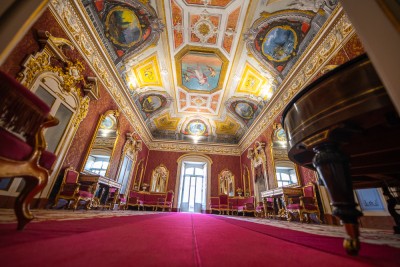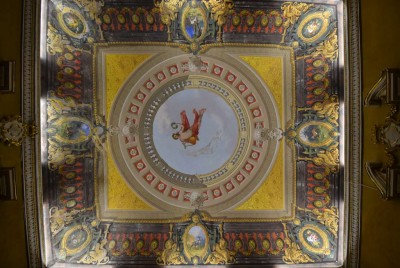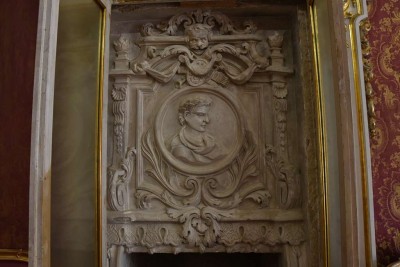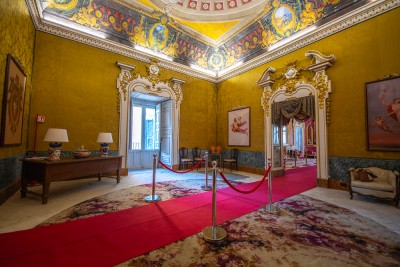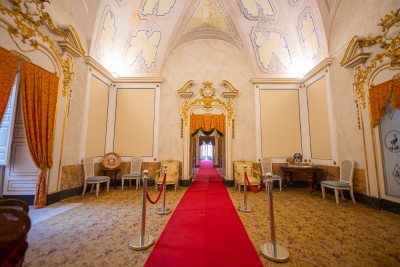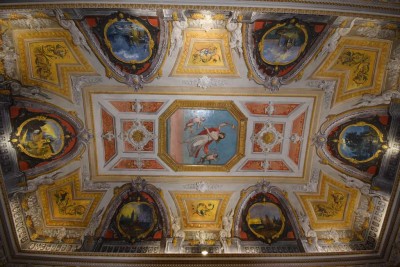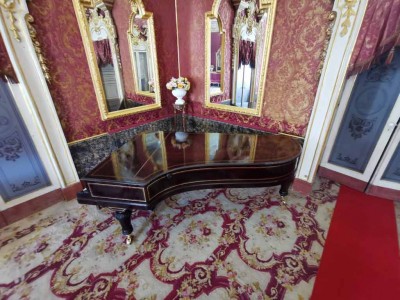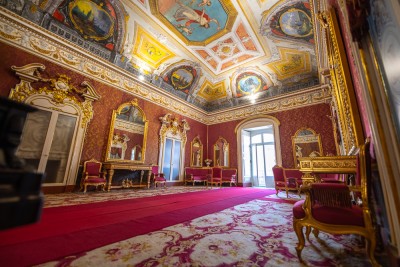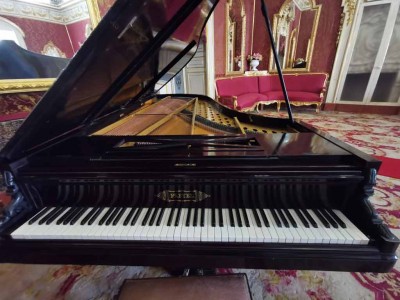ONE OF THE OLDEST PALAZZOS IN CALTAGIRONE, THIS HISTORICAL RESIDENCE CAN BE VISITED BY APPOINTMENT AND IS AVAILABLE FOR PRIVATE EVENTS AND FILM SETS. THERE ARE 5 SALONS IN ADDITION TO A SCENOGRAPHIC ENTRANCE TO THE RESIDENTIAL AREA. DUAL ACCESS FROM VIA SAN BONAVENTURA AND VIA BONANNO (THE LATTER SERVES AS A SECURITY ENTRANCE). IN THE HALL OF MIRRORS THERE IS A PRECIOUS PLEYEL WOLF GRAND PIANO FROM THE 1860S, WHICH CAN BE USED FOR CONCERTS AS IT HAS BEEN PERFECTLY RESTORED.
Contact the abode
Palazzo Spadaro Libertini
Palazzo Spadaro Libertini is a Baroque-style quadrilateral building which was reconstructed after its partial collapse, caused by the earthquake of 1693. Its main entrance is located on Via San Bonaventura, a central street on which the Palazzo has two floors above the ground floor, housing former warehouses that have now become shops. Number 22 Via San Bonaventura serves as the main entrance and has an imposing entrance hall through which one enters a Baroque courtyard decorated with a graceful fountain. On either side of the fountain are the former stables, now also converted into warehouses, while on the right-hand side, there is a Baroque staircase in Comiso stone, illuminated by small circular ‘oculus’ windows that overlook the internal courtyard. Ascending the comfortable curved ‘horse steps’ of the staircase leads to the mezzanine first floor and then the second and final floor.
The history of one of the oldest palazzos in Caltagirone
Palazzo Spadaro Libertini is one of Caltagirone's oldest residences and was rebuilt on a pre-existing 16th-century structure that can be traced back to the unfinished palace that belonged to Bonaventura Secusio, a bishop of Catania and diplomat born in Caltagirone in 1558. Reconstruction work was begun in 1725 by Barbaro Maggiore, the Marquis of Santa Barbara, and was completed in 1732. The Palazzo is located in the historical centre of Caltagirone at 22 Via San Bonaventura, just a short walk from the famous Staircase of Santa Maria del Monte and close to the splendid 17th-century church of San Bonaventura, which miraculously survived the devastating earthquake of 1693 that destroyed most of the monuments and Palazzos in eastern Sicily. In 1871, a descendant of Barbaro Maggiore sold most of the Palazzo to his relative, Michelangelo Libertini of the Barons of San Marco, a noble Caltagirone patrician. He transformed the main ‘piano nobile’ floor, which is now civic number 22, into a sumptuous residence, adorned with white and gold lacquered fixtures and furniture imported from France, as well as damask fabrics and Aubusson carpets specially ordered from textile factories near Versailles and Aubusson respectively, specifically made to measure for the grand salons for which they were intended. The vaulted ceilings of the Salons, which were altered compared to the original Maggiore layout, were decorated by the finest local artists and enriched with paintings by Francesco Vaccaro, a member of the renowned family of artists from Caltagirone, authors of other works to be found in churches and museums in Caltagirone and the surrounding Ragusa area. The doors of the Reception Halls are made of glass embellished with splendid paintings depicting exotic animals and flowers, echoing the decorations on the ceilings with a seamless decorative motif that balances the spatial decor. The other parts of the Palazzo, namely the first floor and the warehouses cum shops, would later be inherited through marriage by another descendant of the Maggiore family, and would be passed down to the father of Count Michele Gravina, grandfather of the the Spadaro di Passanitello heirs. Michelangelo Libertini later donated the ownership of the Palazzo to his children Gesualdo, an important regional politician and Senator of the Kingdom of Savoy, and Francesca, who was married to Baron Salvatore Spadaro di Passanitello. In the absence of direct descendants, Senator Gesualdo Libertini left his entire estate and the Palazzo to his nephew Francesco Spadaro di Passanitello, the son of his sister Francesca, a distinguished historian, heraldist and archaeologist, and a memorable mayor of Caltagirone. The Palazzo, formerly known as Palazzo Libertini, was then renamed Palazzo Spadaro Libertini or Palazzo Spadaro for short. Meetings were held of the Arcadian colony founded in Caltagirone by Barbaro Maggiore's son, Giuseppe, in the second half of the 18th century in the ‘Saloni di Rappresentanza’ reception halls. Later, they were to become the political and cultural salon of Senator Libertini, a prominent and meritorious political figure who passed away in 1948. Subsequently, the owners chose to use the Salons to host important institutions and, within this context, welcomed important guests from the world of literature and politics, not only from Sicily but also at a national level. Architect Alvise Spadaro Gravina, a renowned art historian and leading expert on Caravaggio, has 'handed over the baton', as it were, of the entire representative part of the ‘piano nobile’, which is part of the Palazzo's outstanding artistic, historical and cultural heritage, and thanks to which the residence was declared a monumental property of major artistic interest in 2001, to his cousin Lara Marina Gravina through the family’s Belmonte Beaumont branch. Lara thus took on the responsibility of ‘restoring the beating heart of the Palazzo’. Within the context of a generational transition within the family that binds the Maggiore, Libertini, Spadaro and Gravina families through close kinship, lawyer Lara Marina Gravina di Belmonte, who was born in Milan where she currently lives and works, yet who is deeply attached to the Gravina family's Sicilian roots and traditions, embarked on a complete renovation of the entire representative part and other sections of the Palazzo, together with her mother Gemma. Today, Palazzo Spadaro Libertini has been restored to life in an act of love that not only reflects its own history, but is also of benefit to the city of Caltagirone and the much-beloved island of Sicily. Its renewal serves as a testament that our origins are a part of us that no distance can erase. It was precisely this spirit of 'giving new life to something that seemed destined for oblivion’ that convinced Lara and Gemma Gravina di Belmonte to combine the use of the residence as a private home 'of delights' in the old style, with that of a location for special events destined for a select public, who appreciate its historical importance as well as its absolute splendour.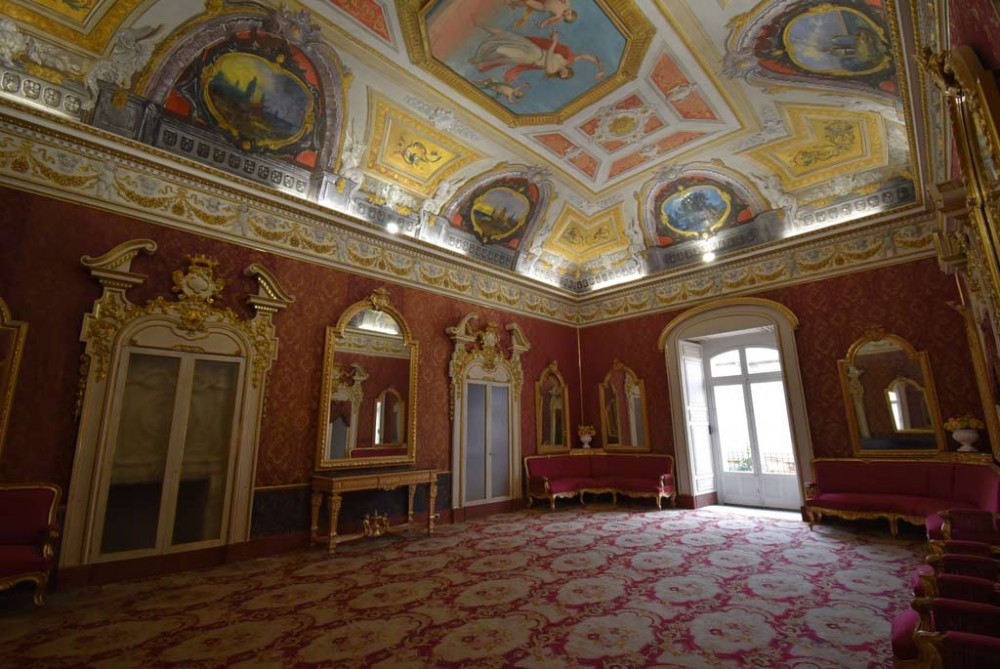
Il Palazzo dei "Carrugi"
Palazzo Spadaro Libertini is not just a historical residence located in the very central Via San Bonaventura, a short walk from the world-famous Staircase of Santa Maria del Monte, but it is also a building that is deeply rooted in the very heart of Caltagirone. It is in fact the only aristocratic dwelling that also boasts an entrance in one of the famous winding 'carruggi' alleys that weave alongside the climbing steps, meaning that the ‘Saloni di Rappresentanza’ can be accessed not only from 22 Via San Bonaventura, but also from 1 Via Bonanno. Caltagirone was at one time a Genoese Colony, after the Genoese victoriously liberated the town from the Saracens in 1030, after which they built the Church of S. Giorgio dei Genovesi as a sign of thanksgiving. The word ‘carruggi’ is therefore a historical legacy that has been preserved over the centuries and refers to these charming alleys of the historic centre, reminiscent of a casbah, giving Caltagirone the quaint nickname of ‘Little Genoa’.
The Pleyel Wolff grand piano in the hall of mirrors
Legend has it that noble patrician Michelangelo Libertini di San Marco not only commissioned all the furnishings in the Palazzo from France, but also ordered a magnificent piano from the renowned Pleyel company, together with harps and other instruments, in order to provide moments of musical entertainment in the Reception Salons. After complete restoration that lasted more than a year, during which all the original parts (strings, hammers and ivory keyboard) were meticulously reconditioned, the Pleyel Wolff Grand Piano, dating back to around 1878, was given a new lease of life. It was tuned slightly below today's 440Hz standard, allowing it to be played in concerts and for accompanying opera singers. Family memoirs report that Richard Wagner, on a visit to Ramacca to see his stepdaughter Blandine, the granddaughter of Franz Liszt, who was engaged and later married to Biagio Gravina di Ramacca, also visited Caltagirone and played on this splendid instrument.
Luigi Capuana and the Spadaro di Passanitello family – a “political” encounter
Of the many important contacts that the Palazzo’s owners made at the time, Luigi Capuana is undoubtedly one of the most prominent. This theorist and leading figure of Verismo sought out and obtained support for his election as Provincial Councillor from Baron Spadaro of Passanitello. He subsequently wrote a letter of thanks to the Baron, preserved in its original form in the Spadaro Archives owned by Architect Alvise Spadaro Gravina, a copy of which is also conserved at Palazzo Spadaro Libertini.
The Caltagirone ceramic collection
The historical residence houses collections of ancient "riggiole", decorative terracotta tiles that were formerly used for the floors of the buildings from which the Palazzo was formed after 1693. In addition, modern works by Master Ceramicists of Caltagirone are permanently on display in the salons, and at certain times of the year visitors can view ancient ceramics from prestigious private collections.
Facilites and service at Palazzo Spadaro Libertini
The reception rooms of Palazzo Spadaro Libertini are perfect for hosting special events such as concerts, exhibitions, conferences and meetings, as well as being a great location for photographic, advertising and film sets. The spaces available include five salons named according to their decorations and tapestries: the Coats of Arms Room, the Marble Room, the Yellow Room, the Hall of Mirrors and the Red and Blue Room. The exceptional acoustics of the Hall of Mirrors and the Yellow Room make them ideal for holding concerts , recitals and film screenings for selected audiences. The entrance to these reception rooms is known as the ‘Castello’ and features a wall dating back to the time of Ruggero I. It is surmounted by a cross vault, thus offering a suggestive 'medieval' atmosphere, ideal as an exhibition space and for cocktail or buffet receptions. In addition, it is possible to hold some afternoon or early evening aperitif-style events outdoors in the Palazzo's entrance area, the picturesque Baroque courtyard or in one of the restored former stables which can be accessed from the courtyard. The Comiso stone staircase leading to the upper floors lends itself to being a highly scenic set for photo and video shoots. The owners are also open to considering other types of events that may be proposed, provided they respect the location’s inherent and inestimable value. The property has an emergency exit to the rear leading onto the ‘carruggio’ alley and fire safety equipment in the form of fire extinguishers. For events and other activities taking place within the Palazzo, the owners prefer to provide their own staff for accreditation and guest reception purposes as well as security services, and exclusively use a trusted catering service offering top-quality service. Smoking is prohibited in all indoor spaces.
Visiting the Palazzo Spadaro Libertini
It is possible to book visits for groups of a minimum of 4 people at certain times of the year. The price is to be agreed upon, based on the number of participants. UNESCO WORLD HERITAGE SITE The Palazzo is located in the historical centre of Caltagirone, a Baroque city in the Val di Noto. Caltagirone was recognised as a UNESCO World Heritage Site in 2002.
How to reach Palazzo Spadaro Libertini
From Catania "Fontanarossa" Airport: approx. 50 km. From Comiso "Pio La Torre" Airport: approx. 35 km. Connections between the Caltagirone train station to and from Catania and Comiso Airports are available using AST and Etna bus/coach services. Car rental with driver provided by Franco Vicino (telephone + 39 335 1681905)
